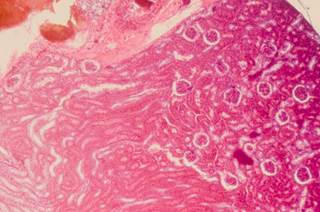|
Stories from the dialysis comunity across the globe.
|
|
Medtronic Fortex PTA High Pressure Balloon to Maintain Access During Dialysis - Medgadget.com (blog) |
 |
 |
|

Medtronic is launching in the U.S. its Fortex percutaneous transluminal angioplasty (PTA) balloon catheter. The over-the-wire device features a high-pressure balloon capable of breaking up some of the toughest build-up to provide access into the peripheral vasculature to be able to perform hemodialysis.
The Fortex has a low profile tip and a flexible shaft that let it stay close to the guidewire, making it easy to pass through difficult vasculature.
The balloon will maintain its shape when within the rated burst pressure, guaranteeing the vessel will stay open during hemodialysis treatment.
Flashback: Covidien’s Fortrex Balloon Catheter Cleared in U.S….
Product page: Fortrex…
Source: Medtronic…
|
|
|
Sunitinib Plus Gemcitabine Active, Well Tolerated in Aggressive Renal Cell ... - Cancer Therapy Advisor |
 |
 |
June 12, 2015

Combination of antiangiogenic therapy and cytotoxic chemotherapy is active and well tolerated in sarcomatoid and RCC.
The combination of antiangiogenic therapy and cytotoxic chemotherapy is active and well tolerated in patients with sarcomatoid and poor-risk renal cell carcinoma (RCC), a recent study published online this week in the journal Cancer has shown.
This single-arm, phase 2 trial evaluated the activity of sunitinib and gemcitabine combination in 39 patients with sarcomatoid RCC and 33 patients with poor-risk RCC.
The primary endpoint was objective response rate (ORR), and secondary endpoints were time to progression (TTP), overall survival (OS), safety, and biomarker correlatives.
Results showed that patients with sarcomatoid RCC and poor-risk RCC had an ORR of 26% and 24%, respectively. Both disease progression and overall survival were slightly higher in patients with poor-risk RCC (TTP=5.5 months; OS=15 months) compared with sarcomatoid RCC (TTP=5 months; OS=10 months).
RELATED: ASPEN Compares Sunitinib, Everolimus in Metastatic Non-Clear Cell Renal Cell Carcinoma
Moreover, patients with greater sarcomatoid histology (>10%) had a higher ORR with stable disease than lower sarcomatoid histology (?10%) (P=0.04). The common grade ?3 adverse events reported were neutropenia (n = 20), anemia (n = 10), and fatigue (n = 7).
The study demonstrates that sunitinib and gemcitabine combination shows activity in both sarcomatoid and poor-risk RCC. Additional studies are currently under investigation to see if combination therapy is better than either therapy alone.
Reference
- Michaelson MD, McKay RR, Werner L, et al. Phase II trial of sunitinib and gemcitabine in patients with sarcomatoid and/or poor-risk metastatic renal cell carcinoma. Cancer. 2015. [Epub ahead of print]. doi: 10.1002/cncr.29503.
|
|
Trends in prevalence of patient case-mix adjusters used in the Medicare ... - NephrologyNews.com |
 |
 |
|
|
Vitamin D might help preserve kidney function in children with CKD - NephrologyNews.com |
 |
 |
|
Delaying ARBs After Surgery Linked to Greater Mortality - Renal and Urology News |
 |
 |
June 12, 2015

Failure to resume ARBs promptly after surgery linked to increased mortality risk, especially in younger patients.
(HealthDay News) -- For veterans regularly prescribed angiotensin receptor blockers (ARBs) admitted for noncardiac surgery, failure to resume ARB therapy by postoperative day 2 is associated with increased mortality risk, according to a study published online in Anesthesiology.
Susan M. Lee, M.D., from the University of California in San Francisco, and colleagues conducted a retrospective cohort study to examine patterns of postoperative ARB use in veterans regularly prescribed ARBs who were admitted for noncardiac surgery between 1999 and 2011. The authors assessed the effect of failure to resume ARBs by postoperative day 2 on all-cause 30-day mortality. Data were included for 30,173 inpatient surgical admissions.
The researchers found that approximately 33.8% of patients did not resume ARBs by postoperative day 2. The 30-day mortality rate was 1.3% for those who resumed ARBs, compared with 3.2% for those who had ARBs withheld (multivariable adjusted hazard ratio, 1.74; P < 0.001). In a propensity score-matched subset of 19,490 patients, the hazard ratio was similar (hazard ratio, 1.47; P < 0.001). The mortality risk was increased in younger patients who did not resume ARBs (hazard ratio, 2.52; P < 0.001 for those younger than 60 years) compared with older patients (hazard ratio, 1.42; P < 0.01 for patients aged older than 75 years).
"Withholding ARBs is strongly associated with increased 30-day mortality, especially in younger patients, although residual confounding may be present," the authors write.
Source
- Lee, SM, et al. Anesthesiology, published May 2015; doi: 10.1097/ALN.0000000000000739.
|
|
|
|
|
<< Start < Prev 161 162 163 164 165 166 167 168 169 170 Next > End >>
|
|
Page 165 of 4210 |
 Log in to explore the world's most comprehensive database of dialysis centres for free!
Log in to explore the world's most comprehensive database of dialysis centres for free!  Professional dialysis recruitment
Professional dialysis recruitment





